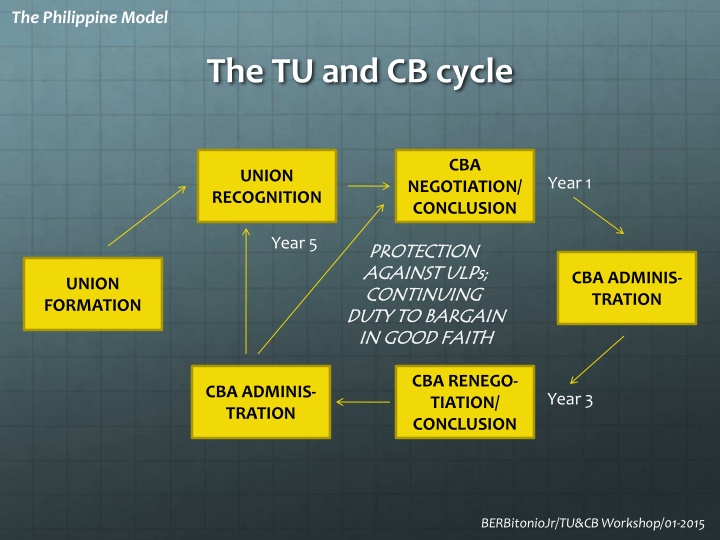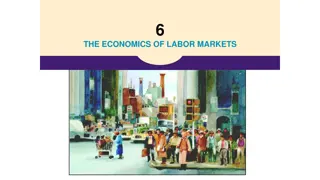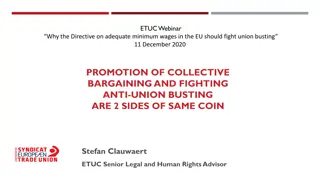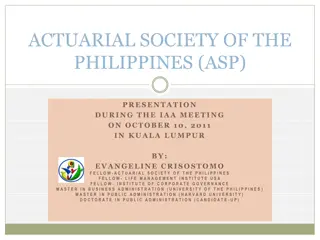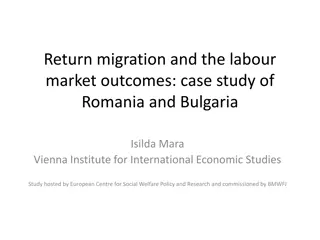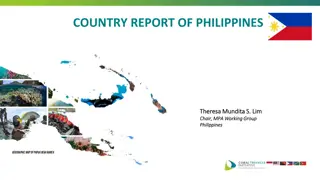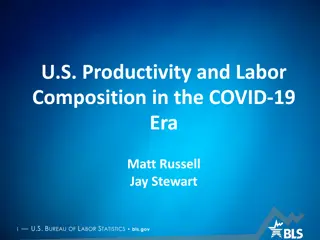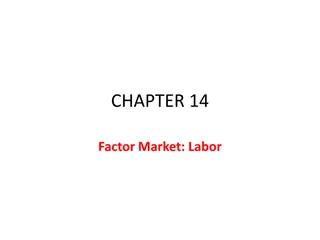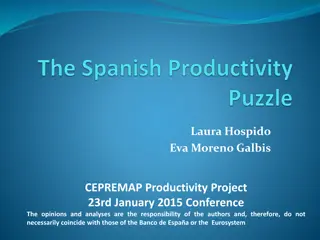Labor Market Trends and Union Growth in the Philippines
The Philippine model of trade unionism involves a cycle of union recognition, negotiation, and conclusion, with a continuing duty to bargain in good faith. The trade union structure consists of three levels with one level of collective bargaining. The context of trade unions and collective bargaining reveals issues of employment growth by sector and labor market dualism. Policy outcomes show stagnant union growth and falling membership.
Download Presentation

Please find below an Image/Link to download the presentation.
The content on the website is provided AS IS for your information and personal use only. It may not be sold, licensed, or shared on other websites without obtaining consent from the author.If you encounter any issues during the download, it is possible that the publisher has removed the file from their server.
You are allowed to download the files provided on this website for personal or commercial use, subject to the condition that they are used lawfully. All files are the property of their respective owners.
The content on the website is provided AS IS for your information and personal use only. It may not be sold, licensed, or shared on other websites without obtaining consent from the author.
E N D
Presentation Transcript
The Philippine Model The TU and CB cycle CBA UNION RECOGNITION Year 1 NEGOTIATION/ CONCLUSION Year 5 PROTECTION PROTECTION AGAINST ULPs; AGAINST ULPs; CONTINUING CONTINUING DUTY TO BARGAIN DUTY TO BARGAIN IN GOOD FAITH IN GOOD FAITH CBA ADMINIS- TRATION UNION FORMATION CBA RENEGO- TIATION/ CONCLUSION CBA ADMINIS- TRATION Year 3 BERBitonioJr/TU&CB Workshop/01-2015
The Philippine Model The trade union structure Three levels of unionism, one level of collective bargaining - PEAK ORGANIZATION Engages in political unionism Assists or acts as agent in enterprise collective bargaining Sits in policymaking bodies Trade Union Center enterprise collective bargaining Sits in policy making bodies FEDERATION Assists or acts as agent in Industry or National Union General Union ENTERPRISE UNION Principal in enterprise collective bargaining Independen t Union Local Chapter Affiliate BERBitonioJr/TU&CB Workshop/01-2015
Context of TU and CB Employment growth by sector GDP Growth Rate (%) Employment Growth Rate (%) Sector Agriculture 1.1 -2.8 Industry 9.5 3.0 Services 7.1 2.4 All Sectors 7.2 0.8 High GDP growth rate with low employment creation (jobless growth). Structural nature of employment problem. BERBitonioJr/TU&CB Workshop/01-2015
Context of TU and CB Labor market dualism persists Labor market dualism persists, leaning increasingly toward non-standard employment arrangements and informalization. FORMAL SECTOR (Wage and salary) Precarious employment Private household 1.959 million Private establishment 17.033 million Gov t/GOCC 3.018 million Own family-operated farm or business 0.127 million Employer 1.263 million Vulnerable employment INFORMAL SECTOR Unpaid family workers 3.908 million Self-employed 10.610 million BERBitonioJr/TU&CB Workshop/01-2015
Policy outcomes Union growth is stagnant to slow 1.855 M union members in 2013: 1.392 M in 16,638 enterprise- based private sector and 463,000 in 1,769 public sector unions. Year New unions (private) Total unions (private) Total membership (private) and % of wage sector Total unions (public) Total membership (public) 2007 260 17,021 1, 917,707 (11%) 1,563 334,319 2008 279 17,305 1,941,727 (10.9%) 1,628 343,477 2009 384 17,665 1,985,467 (10.6%) 1,676 356,279 2010 335 17,973 1,713,593 (8.7%) 1,706 360,680 2011 297 18,242 1,778,824 (8.7%) 1,709 402,851 2012 189 18,428 1,833,341 (8.5%) 1,742 446,044 BERBitonioJr/TU&CB Workshop/01-2015
Policy outcomes TU density and membership continue falling Total employment and union membership, 2004 -2013 (in 000) 4,000 3,500 3,000 2,500 2,000 1,500 1,000 500 0 2,004 2,582 521 2009 2,991 373 2011 3,020 319 2013 3,739 371 EMP MEM Trade union density, 2004-2013 (in %) 30 20 10 0 2004 20 2009 12.5 2011 10.6 2013 9.9 DEN BERBitonioJr/TU&CB Workshop/01-2015
Policy outcomes CB coverage stagnant, CBC rate falling Collective bargaining coverage, 2003-2013 (in 000) 600 400 200 0 2003 508 2004 415 2006 423 2008 391 2010 330 2012 383 CBC Collective bargaining coverage rate, 2003-2013 (in %) 25 20 15 10 5 0 2003 19.7 2004 17.3 2008 13.1 2010 10.9 2012 10.3 CBC Rate BERBitonioJr/TU&CB Workshop/01-2015
Policy outcomes TU and CB activities concentrated in urbanized regions where W&S sector is larger Direct correlation between urbanization and trade union and collective bargaining activity. 9,898 unions (59% of all enterprise-based private sector unions) with 1.069 members (76.8%) are in NCR. 2,122 unions with 180,000 members in CALABARZON. 1,068 unions with 98,000 members in Central Luzon. BERBitonioJr/TU&CB Workshop/01-2015
Policy outcomes Organizing for new unions is limited Only a few new unions in urbanized regions, none in the less urbanized. 99 new unions with 4,447 members were registered in 2013, mostly in NCR. No newly registered unions in CAR and Regions I, II, VIII, IX, CARAGA and ARMM. Hardly any evidence of new organizing activity in Regions IV-B, X and XI (one new union each). Slight increase in number of unions and members, but lower union membership-to-employment ratio. BERBitonioJr/TU&CB Workshop/01-2015
Policy outcomes Fewer certification elections year on year 211 original Med-Arb cases, mostly PCEs, were in the dockets in 2013. 96 cases were on appeal. 2010: 312 PCEs 2006: 489 PCEs 2005: 517 PCEs Of the 211 cases, 138 were disposed, with 102 granted and 38 dismissed/withdrawn. 2012 and 2011 (258/301 and 235/278, respectively). Of the 195 newly-filed original cases, 116 were in NCR, 21 in Region III, and 14 in CALABARZON. No cases in CAR and Regions I, II, III, IV-B, IX and X. BERBitonioJr/TU&CB Workshop/01-2015
Policy outcomes Number and coverage of CBAs decreasing We are losing more CBAs than gaining new ones. Loss of CBAs mostly due to company closures. Year Newly-filed Coverage Total CBAs Total coverage 2005 459 82,925 2,973 556,000 2006 536 60,790 2,700 235,887 2007 318 44,375 1,542 218,128 2008 307 55,290 1,4566 227,403 2009 453 74,924 1,394 225,167 2010 540 87,445 1,413 212,054 2011 475 77,944 1389 227,620 2012 365 58,138 1,327 219,899 BERBitonioJr/TU&CB Workshop/01-2015
Policy outcomes Where CB happens, no evidence of distributional impact . . . Increase in proportion of wage and salary workers in recent years did not increase CB coverage . . . 70 60 . . . and increase in wage share to GDP cannot be attributed to CB. 50 40 30 20 10 0 2003 2004 2008 2010 2012 Proportion of workers in wage and salary sector (public and private) Collective bargaining coverage rate Wage share to GDP 50.1 52.1 52.4 54.5 57.2 19.7 17.3 13.1 10.9 10.3 24.5 27.6 27.8 32.2 35.4 BERBitonioJr/TU&CB Workshop/01-2015
Policy outcomes Industrial peace, or simply no voice? Fewer union and collective bargaining activity directly correlated with less collective disputes. 177 NOS/NOL, with 149 new cases, were filed in 2013. 274 and 184 NOS/NOL in the dockets in 2012 and 2011. One actual strike in 2013; 1,000 man-days lost. 5 strikes and 5,000 man-days lost in 2011 and 2012. Total PM and VA cases decreased from 2011 to 2013. PM from 585 to 484. VA from 249 to 230. BERBitonioJr/TU&CB Workshop/01-2015
Toward a strategic framework POLICY PERFORMANCE IS POOR. NO NEED TO CHANGE POLICY GOALS AND OBJECTIVES. . . The ENDS are fundamental and universal which all free and democratic societies seek to achieve. . . . BUT THE MEANS TO ACHIEVE THESE ARE NO LONGER EFFECTIVE. Strategic transformation should aim to re-design the TU/CB model, especially the characteristics which constrain FoA, TU and CB. BERBitonioJr/TU&CB Workshop/01-2015
Toward a strategic framework Variations in TU and CB outcomes H T U D E N S I T Y High TU density High TU density Low CB coverage High CB coverage t Low TU density Low TU density Low CB coverage High CB coverage L CB COVERAGE BERBitonioJr/TU&CB Workshop/01-2015
Variations in TU and CB outcomes Samples from around the world H T U D E N S I T Y Italy Belarus Cuba Denmark Finland Norway Belgium South Africa Canada UK Aus Austria Singapore NZ Malaysia Brazil Germany US France L CB COVERAGE BERBitonioJr/TU&CB Workshop/01-2015
Variations in TU and CB outcomes How the Philippines compares H T U D E N S I T Y Italy Belarus Cuba Denmark Finland Norway Belgium South Africa Canada UK Aus Austria Singapore NZ Malaysia Philippines Brazil Germany US France L CB COVERAGE BERBitonioJr/TU&CB Workshop/01-2015
Variations in TU and CB outcomes Samples from around the world TU density and CB coverage from various countries: International Statistical Inquiry, 2008-2009, ILO (2010) 120 100 80 60 40 20 0 Canada Belgium Philippines Austria Finland Korea Singapore UK Cuba US Australia Germany Italy South Africa Brazil Chile Denmark Norway Japan Belarus France New Zealand Malaysia Indonesia Trade union density Collective bargaining coverage rate BERBitonioJr/TU&CB Workshop/01-2015
Variations in TU and CB outcomes Lessons from the samples There are correlations between economic and labor market factors and TU and CB outcomes - Positive correlation between level of economic development and higher TU density (HIGH TUD) and CB coverage rates (HIGH CBC). . . . but high level of development does not guarantee HIGH TUD/HIGH CBC . Positive correlation between large formal sector and HIGH TUD/HIGH CBC. Inverse correlation between informality and HIGH TUD/HIGH CBC. BERBitonioJr/TU&CB Workshop/01-2015
Variations in TU and CB outcomes Lessons from the samples Political structures with a defined role for unions positively influence TU and CB outcomes. Countries moving toward HIGH TUD and HIGH CBC - Tend to have labor parties or institutionalized role of unions in political decision-making. Tend to be guided by the post-WWII social bargain. Are or tend to have elements of the welfare State. Tend to be parliamentary democracies. Have long experience with C. 87 and C. 98. BERBitonioJr/TU&CB Workshop/01-2015
Variations in TU and CB outcomes TU and CB model plays a key role Similar characteristics, similar outcomes - H Developed economy Large formal sector Peak organizations Corporatist and democratic coalitions Coordinated, multi-level CB model Employee termination must be for cause Ergo omnes provisions Transition economy Large public sector employment and State-owned enterprises State-led organizations with compulsory membership Undeveloped CB structure Evolving labor law Developed economy Large formal sector Peak organizations Democratic and competitive representation Coordinated, multi-level CB model Employee termination must be for cause Ergo omnes provisions Developed or developing economies Large or small informal sector Union pluralism Decentralized CB model Democratic and competitive representation L BERBitonioJr/TU&CB Workshop/01-2015
Developing a strategy for transformation All TU/CB models expressly aim to promote FoA, TU and CB. However - As local and international experience show, the elements and characteristics of a particular model may, in operation, frustrate its stated goals and objectives. Procedures may have the unintended consequence of rendering ineffective explicit substantive rights. BERBitonioJr/TU&CB Workshop/01-2015
Developing a transformation strategy Recent reform initiatives Recent reform initiatives follow a piecemeal approach of amending the Labor Code. R.A. 9347 (2007), Rationalizing the composition of the NLRC R.A. 9481 (2007), Strengthening workers Constitutional right to self-organization R.A. 10395 (2013), Strengthening tripartism R.A. 10396 (2013), Strengthening conciliation and mediation These reforms are procedural in nature. BERBitonioJr/TU&CB Workshop/01-2015
Developing a transformation strategy Planned reform initiatives Planned reform initiatives contained in PLEP continue with the piecemeal approach Reducing minimum membership requirements and number of unions required to form a federation Repeal of prohibition against unions to receive foreign assistance Strengthening the rights of non-regular workers in the informal economy to self-organization Passage of Magna Carta for Workers in the Informal Economy BERBitonioJr/TU&CB Workshop/01-2015
Developing a transformation strategy Planned reform initiatives Planned reform initiatives contained in PLEP continue with the piecemeal approach - Amendment of Arts. 213-233 of the Labor Code toward introducing reforms in the NLRC Direct appeal of VA and NLRC cases to SC Amendment of compulsory arbitration provisions on national interest cases. BERBitonioJr/TU&CB Workshop/01-2015
Developing a transformation strategy Nature and scope of initiatives Stated general direction of recent and planned reforms is to align the laws with ILO Conventions. However - Reform initiatives are focused only on the first and fourth core elements (FoA and TU rights and dispute resolution). No initiatives on the second and third core elements (representation and structure and scope of CB). All the initiatives are procedural in nature. BERBitonioJr/TU&CB Workshop/01-2015
Developing a transformation strategy The case for a transformational model In all, the initiatives tend TO PRESERVE AND SOLIDIFY the existing model, NOT TO TRANSFORM it. Time to rethink piecemeal approach and develop one that is more strategic, purposeful and coordinated. Tripartite partners should draw lessons and guidance from national and international experience. Look BEYOND THE CURRENT MODEL. ELIMINATE THE CONSTRAINING ELEMENTS AND CHARACTERISTICS. BERBitonioJr/TU&CB Workshop/01-2015
Developing a transformation strategy Identifying the constraints (1) CORE ELEMENT CHARACTERISTICS Eligibility for TU membership conditioned on employment status and classification Minimum requirements for TU to acquire legal personality State-administered registration system Pluralist, decentralized and enterprise-based TU structure Protection against anti-union discrimination, coercion and ULPs Formal recognition of right to federate or form central organizations for TUs, informal recognition for employers First element: Recognition, promotion and regulation of FoA and TU rights BERBitonioJr/TU&CB Workshop/01-2015
Developing a transformation strategy Eligibility for TU membership Within a standard Ee-Er relationship, eligibility requirements can actually restrict FoA rights - Ineligibility of managers and eligibility of supervisors In point: United Pepsi-Cola Supervisory Union v. Laguesma, G. R. No. 122226, 25 March 1998. Disguised ineligibility: an employer includes any person acting in the interest of the employer. Practice of excluding specific groups or non- regular employees deemed eligible by law. BERBitonioJr/TU&CB Workshop/01-2015
Developing a transformation strategy Eligibility for TU membership Within an Ee-Er relationship, but under a non- standard employment arrangement (including subcontracting): legal recognition of eligibility has little practical impact. Within an Ee-Er relationship simultaneously with some other relationship: disqualification of employees in cooperatives who are also members thereof. Outside an Ee-Er relationship: the unemployed, own account workers and the informal sector. BERBitonioJr/TU&CB Workshop/01-2015
Developing a transformation strategy Identifying the constraints (2) CORE ELEMENT CHARACTERISTICS Enterprise-based bargaining units Membership in bargaining units based on common employee classification and interests Democratic and competitive selection, thru certification election, of the union which will serve as the sole and exclusive bargaining representative for workers Fixed term of representation Multi-level appellate recourse to question selection of bargaining representative Second element: Recognition, promotion and regulation of CB rights BERBitonioJr/TU&CB Workshop/01-2015
Developing a transformation strategy Bargaining unit determination In spite of explicit preference for a one employer, one bargaining unit policy, bargaining units have become smaller. Legal principle that determination of BU and employee classification is a prejudicial issue to CB can work as an obstacle to actual CB. In point: San Miguel Supervisors and Exempt Employees Union v. Laguesma, G.R. No. 110399, 15 Aug. 1997, and G. R. No. 146206, 01 Aug., 2011. Inclusion-exclusion proceedings and double appeal in PCEs are the graveyard of unions. BERBitonioJr/TU&CB Workshop/01-2015
Developing a transformation strategy Exclusivity of representation Is a certification election the only way to express the employees choice of CB representative? Should representation be always exclusive to one union? With the proposal for industry or other forms of bargaining outside the enterprise, how will representation be determined? Where there is more than one union in a B.U., will composite or coalitional rather than exclusive representation facilitate CB? BERBitonioJr/TU&CB Workshop/01-2015
Developing a transformation strategy Identifying the constraints (3) CORE ELEMENT CHARACTERISTICS Decentralized and enterprise-based structure Formal recognition of duty to bargain in good faith, with guidelines on bargaining process Protection against bad faith bargaining and related forms of ULP Fixed term of CBA; periodic nature of bargaining Minimum labor standards are baselines to CB Binding between the parties within the BU, non-extendible to workers outside the BU Recognition of union security clauses Minimum State intervention in the CB process Third element: Structure, process, scope and content of CB BERBitonioJr/TU&CB Workshop/01-2015
Developing a transformation strategy Enterprise level bargaining Key issues - Coverage of CB and application of employee classifications A possible trend toward smaller bargaining units and more exclusions Term of CBA (3-2, 3-3 or simply 3): Term confers workers the legal right to review the terms of the CBA at regular and periodic intervals. In counter-point: Rivera v. Espiritu, G. R. No. 15547, 23 January 2002. BERBitonioJr/TU&CB Workshop/01-2015
Developing a transformation strategy Higher level bargaining Key issues in formulating an institutional mechanism for bargaining outside the enterprise level Coverage of CB and application of employee classifications Choice of representation Should there be representation even without TU membership? Nature of agreements: framework or binding? Scope of application: exclusive to signatories or with ergo omnes application? BERBitonioJr/TU&CB Workshop/01-2015
Developing a transformation strategy Identifying the constraints (4) CORE ELEMENT CHARACTERISTICS Classification of disputes: bargaining deadlocks, gross violation or implementation or interpretation of CBA provisions Requirements for strike and lockout; consequences for non-compliance Sequential principles in dispute settlement Shared responsibility: parties to resolve their dispute thru consensus Outside the enterprise, preferred mode is conciliation, mediation and VA. Compulsory arbitration for national interest cases Multi-level appellate and judicial recourse Fourth element : Dispute settlement BERBitonioJr/TU&CB Workshop/01-2015
Developing a transformation strategy Labor disputes Definition of strike now includes instances where workers do not actually withhold their labor. In point:NUWHRAIN Dusit Hotel Nikko Chapter v. Court of Appeals, G. R. No. 166295, 11 November 2008. Proposal to make voluntary arbitrator s decision directly appealable to the Supreme Court Pro: Shortens the appellate process Cons: Undermines binding nature of VA; in turn undermines CB; may create a perverse incentive for parties not to submit to VA. BERBitonioJr/TU&CB Workshop/01-2015
Developing a transformation strategy Building on what we have Some institutionalized tripartite and social dialogue processes are forms of bargaining outside the enterprise Wage fixing Specialized regulations for non-standard work arrangements (subcontracting) Specialized industry regulations (construction and security industries) Specialized regulations on hazardous work Multi-employer employment contracts with international application (standard employment contract for seafarers) BERBitonioJr/TU&CB Workshop/01-2015
Developing a transformation strategy Drawing from other instruments In considering policy options, tripartite partners should not be confined to the current model or to the terms of C. 87 and C. 98. Other instruments, even those not ratified by the Philippines, are instructive C. 154 (Collective Bargaining Convention, 1981) R. 163 (Collective Bargaining Recommendation, 1981) R. 91 (Collective Agreements Recommendation, 1951) BERBitonioJr/TU&CB Workshop/01-2015
Developing a transformation strategy From CBA to COLLECTIVE AGREEMENTS A broader conceptualization from CBA to collective agreements will still be within the framework of C. 87, C. 98, tripartism and social dialogue Collective agreements means all agreements in writing regarding working conditions and terms of employment concluded between an employer, a group of employers or one or more employers' organisations, on the one hand, and one or more representative workers' organisations, or, in the absence of such organisations, the representatives of the workers duly elected and authorised by them in accordance with national laws and regulations, on the other. (ILO R. 91) BERBitonioJr/TU&CB Workshop/01-2015
Developing a transformation strategy Targeting strategic goals and outcomes, one step at a time Long term Influence Mid term Partnership Short term Redistribution > TU density Social justice > CB coverage New model Education Advocacy BERBitonioJr/TU&CB Workshop/01-2015
THANK YOU FOR YOUR ATTENTION!
